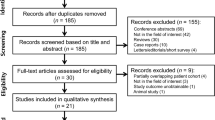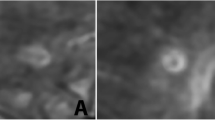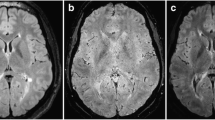Abstract
Objectives
Susceptibility weighted imaging (SWI) may have the potential to depict the perivenous extent of white matter lesions (WMLs) in multiple sclerosis (MS). We aimed to assess the discriminatory value of the “central vein sign” (CVS).
Methods
In a 3-T magnetic resonance imaging (MRI) study, 28 WMLs in 14 patients with at least one circumscribed lesion >5 mm and not more than eight non-confluent lesions >3 mm were prospectively included. Only WMLs in FLAIR images with a maximum diameter of >5 mm were correlated to their SWI equivalent for CVS evaluation.
Results
Five patients fulfilled the revised McDonald criteria for MS and nine patients were given alternative diagnoses. Nineteen MS-WMLs and nine non-MS-WMLs >5 mm were detected. Consensus reading found a central vein in 16 out of 19 MS-WMLs (84 %) and in one out of nine non-MS-WMLs (11 %), respectively. The CVS proved to be a highly significant discriminator (P < 0.001) between MS-WMLs and non-MS-WMLs with a sensitivity, specificity, positive and negative predictive value and accuracy of 84 %, 89 %, 94 %, 73 % and 86 %, respectively. Inter-rater agreement was good (κ = 0.77).
Conclusions
Even though the CVS is not exclusively found in MS-WMLs, SWI may be a useful adjunct in patients with possible MS.
Key Points
• MRI continues to yield further information concerning MS lesions.
• SWI adds diagnostic information in patients with possible MS.
• The “central vein sign” was predominantly seen in MS lesions.
• The “central vein sign” helps discriminate between MS and non-MS lesions.





Similar content being viewed by others
Abbreviations
- AP:
-
Antero-posterior
- CDMS:
-
Clinically definite multiple sclerosis
- CIS:
-
Clinically isolated syndrome
- CV:
-
central vein
- CVS:
-
Central vein sign
- DD:
-
Differential diagnosis
- DIS:
-
Dissemination in space
- DIT:
-
Dissemination in time
- FH:
-
Feet-head
- FLAIR:
-
Fluid-attenuated inversion-recovery
- mIP:
-
Minimum intensity projection
- MS:
-
Multiple sclerosis
- PACS:
-
Picture archiving and communication system
- RIS:
-
Radiologically isolated syndrome
- RL:
-
Right-left
- SOCR:
-
Statistics Online Computational Resource
- SWI:
-
Susceptibility weighted imaging
- WML:
-
white matter lesion
References
Noseworthy JH, Lucchinetti C, Rodriguez M, Weinshenker BG (2000) Multiple sclerosis. N Engl J Med 343:938–952
Renoux C, Vukusic S, Mikaeloff Y et al (2007) Natural history of multiple sclerosis with childhood onset. N Engl J Med 356:2603–2613
Okuda DT, Mowry EM, Beheshtian A et al (2009) Incidental MRI anomalies suggestive of multiple sclerosis: the radiologically isolated syndrome. Neurology 72:800–805
Poser CM, Paty DW, Scheinberg L et al (1983) New diagnostic criteria for multiple sclerosis: guidelines for research protocols. Ann Neurol 1:227–231
McDonald WI, Compston A, Edan G et al (2001) Recommended diagnostic criteria for multiple sclerosis: guidelines from the International Panel on the diagnosis of multiple sclerosis. Ann Neurol 50:121–127
Tintoré M, Rovira A, Río J et al (2003) New diagnostic criteria for multiple sclerosis. Application in first demyelinating episode. Neurology 60:27–30
Polman CH, Reingold SC, Banwell B et al (2011) Diagnostic criteria for multiple sclerosis: 2010 revisions to the McDonald criteria. Ann Neurol 69:292–302
Filippi M, Rocca MA (2011) MR imaging of multiple sclerosis. Radiology 259:659–681
Fazekas F, Kleinert R, Offenbacher H et al (1991) The morphologic correlate of incidental punctate white matter hyperintensities on MR images. AJNR Am J Neuroradiol 12:915–921
Breteler MM, van Swieten JC, Bots ML et al (1994) Cerebral white matter lesions, vascular risk factors, and cognitive function in a population-based study: the Rotterdam Study. Neurology 44:1246–1252
de Leeuw FE, de Groot JC, Achten E et al (2001) Prevalence of cerebral white matter lesions in elderly people: a population based magnetic resonance imaging study. The Rotterdam Scan Study. J Neurol Neurosurg Psychiatry 70:9–14
Putnam TJ (1933) The pathogenesis of multiple sclerosis: a possible vascular factor. N Engl J Med 209:786–790
Fog T (1965) The topography of plaques in multiple sclerosis with special reference to cerebral plaques. Acta Neurol Scand Suppl 15:1–161
Horowitz AL, Kaplan RD, Grewe G, White RT, Salberg LM (1989) The ovoid lesion: a new MR observation in patients with multiple sclerosis. AJNR Am J Neuroradiol 10:303–305
Filippi M, Rocca MA, Barkhof F et al (2012) Attendees of the Correlation between Pathological MRI findings in MS workshop. Association between pathological and MRI findings in multiple sclerosis. Lancet Neurol 11:349–360
Ge Y, Zohrabian VM, Grossman RI (2008) Seven-Tesla magnetic resonance imaging: new vision of microvascular abnormalities in multiple sclerosis. Arch Neurol 65:812–816
Tallantyre EC, Morgan PS, Dixon JE et al (2009) A comparison of 3T and 7T in the detection of small parenchymal veins within MS lesions. Invest Radiol 44:491–494
Grabner G, Dal-Bianco A, Schernthaner M, Vass K, Lassmann H, Trattnig S (2011) Analysis of multiple sclerosis lesions using a fusion of 3.0 T FLAIR and 7.0 T SWI phase: FLAIR SWI. J Magn Reson Imaging 33:543–549
Haacke EM, Xu Y, Cheng YC, Reichenbach JR (2004) Susceptibility weighted imaging (SWI). Magn Reson Med 52:612–618
Lummel N, Boeckh-Behrens T, Schoepf V, Burke M, Brückmann H, Linn J (2011) Presence of a central vein within white matter lesions on susceptibility weighted imaging: a specific finding for multiple sclerosis? Neuroradiology 53:311–317
Carmody DP, Dunn SM, Boddie-Willis AS, DeMarco JK, Lewis M (2004) A quantitative measure of myelination development in infants, using MR images. Neuroradiology 46:781–786
Dinov ID (2006) SOCR: Statistics Online Computational Resource. J Stat Softw 16:1–16
Jacobs DL, Beck RW, Simon JH et al (2000) Intramuscular interferon beta-1a therapy initiated during a first demyelinating event in multiple sclerosis. N Engl J Med 343:898–904
Enzinger C, Smith S, Fazekas F et al (2006) Lesion probability maps of white matter hyperintensities in elderly individuals: results of the Austrian stroke prevention study. J Neurol 253:1064–1070
Barkhof F, Filippi M, Miller DH et al (1997) Comparison of MRI criteria at first presentation to predict conversion to clinically definite multiple sclerosis. Brain 120:2059–2069
Tan IL, van Schijndel RA, Pouwels PJ, van Walderveen MA, Reichenbach JR, Manoliu RA, Barkhof F (2000) MR venography of multiple sclerosis. AJNR Am J Neuroradiol 21:1039–1042
Adams CWM, Poston RN, Buk SJ (1989) Pathology, histochemistry and immunocytochemistry of lesions in acute multiple sclerosis. J Neurol Sci 92:291–306
Ge Y, Zohrabian VM, Osa EO et al (2009) Diminished visibility of cerebral venous vasculature in multiple sclerosis by susceptibility-weighted imaging at 3.0 Tesla. J Magn Reson Imaging 29:1190–1194
Zivadinov R, Poloni GU, Marr K et al (2011) Decreased brain venous vasculature visibility on susceptibility-weighted imaging venography in patients with multiple sclerosis is related to chronic cerebrospinal venous insufficiency. BMC Neurol 11:128
Reichenbach JR, Venkatesan R, Schillinger DJ, Kido DK, Haacke EM (1997) Small vessels in the human brain: MR venography with deoxyhemoglobin as an intrinsic contrast agent. Radiology 204:272–277
Hodel J, Rodallec M, Gerber S et al (2012) Susceptibility weighted magnetic resonance sequences “SWAN, SWI and VenoBOLD”: technical aspects and clinical applications. J Neuroradiol 39:71–86
Acknowledgements
The abstract of this scientific paper (ctrl no. 2123) has been accepted for oral presentation at ECR 2013.
Author information
Authors and Affiliations
Corresponding author
Rights and permissions
About this article
Cite this article
Kau, T., Taschwer, M., Deutschmann, H. et al. The “central vein sign”: is there a place for susceptibility weighted imaging in possible multiple sclerosis?. Eur Radiol 23, 1956–1962 (2013). https://doi.org/10.1007/s00330-013-2791-4
Received:
Revised:
Accepted:
Published:
Issue Date:
DOI: https://doi.org/10.1007/s00330-013-2791-4




